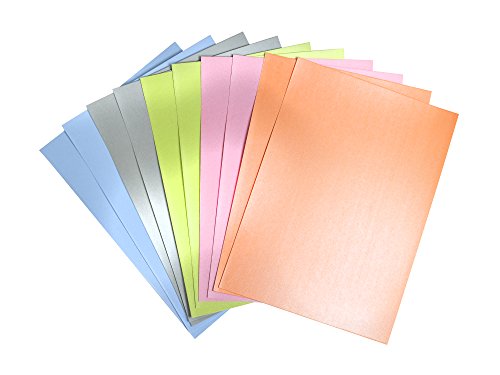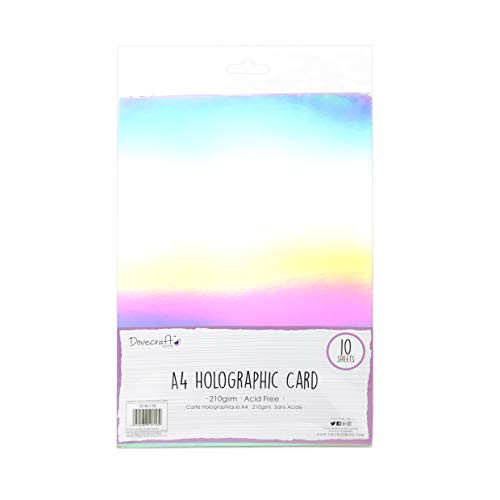Paper and card are essential craft materials, so it makes sense that there’s lots of choice on offer – different sizes, weights and lots of different finishes. Whilst this variety’s great for your crafting, it can be daunting if you’re just starting out. We thought we’d help by putting together some simple guides to paper and card stock.
Types of Paper and Card
1. Pearlescent Card and Paper
Pearlescent card and paper comes in a wide choice of colours (with a plain white back), and has a pearl-like finish. It’s a great choice if you want something with a bit more shine than plain matt, but don’t want to go mirrored or glittery. Because pearlescent card is white on one side it’s particularly handy for folding into card blanks, since it gives you a plain white inside to write on.
2. Textured Card
Great for giving a luxurious feel to your cards. Textured card gives instant depth and detail, without the need for embossing. There are lots of different textures available, but perhaps the most popular are leather effect, silkweave and hammer. Leather effect is marked with faux creases which resemble the naturally occuring creases in leather. Silkweave is subtly textured with a thread pattern that mimics raw silk or linen. Hammer texture has lots of little indentations, just like it’s been hit all over with a tiny hammer. You might want to stick to one texture, or use combinations of different textures to create contrast in your cards.
3. 3D Decoupage Paper
3D decoupage is ideal if you’re just starting out in card making, because it’s easy to use and creates the main focal point of your card. Decoupage sheets are printed with one or more designs, each with several parts which you layer up to make a 3D centrepiece. In each finished design, the layer at the bottom is largest, and the top layer the smallest. Though most designs only have about 4-5 layers in total, you can create more height by using foam pads or glue dots to stick each layer. Many decoupage sheets are die-cut so you don’t even need to use scissors – just push out the parts from the sheet and layer them up, sticking as you go. As well as regular decoupage, there is also pyramid decoupage (square layers), and oval decoupage.
4. Mirri Card
Mirri card is reflective mirrored card which comes in a range of colours. It’s a great way to add shine to your cards, particularly at Christmas time when sparkle and shine are practically compulsory. At Handy Hippo we have packs of mirri card in assorted colours so you’ve got the choice of combining colours without needing to buy separate packs. As well as generally adding shine, silver mirri card is great for representing water on your cards.
5. Holo Card
Holo card has a shimmery holographic coating on one side and is plain white on the back. The holographic side seems to change colour when the light bounces off it at different angles. While you might not want to make a whole card out of holographic card, it’s a great way to add a stand-out element – kids in particular love the space-age effect.
6. Glitter Card
Glitter card has a generous coating of glitter on one side, and is available in lots of different colours. If you want to make a really eye-catching card, maybe with a disco or party theme, there’s nothing sparklier. As with all glitter-covered materials, you will end up finding glitter all round your house for weeks after using glitter card, but that’s all part of the fun…
7. Mulberry Paper
Mulberry paper is delicate paper which you can tear when wet to create feathered edges. Tearing it by hand gives it an irregular finish which is unique every time – giving your cards an authentic artisan look. It’s also great for using in scrapbooks.
8. Patterned/Scrapbook Paper
Patterned papers come in different sizes, most commonly 12×12″, 6×6″ and A4, and are printed with colourful designs to add instant background detail to cards and scrapbooks. Patterned papers come in lots of different themes and colour schemes, so that no matter who you’re making a card for, you should be able to find something appropriate for them. They look particularly effective when layered with complementary patterned or coloured papers.
9. Vellum Paper
Nothing says luxury card like a sheet of vellum. Vellum is thin and delicate and adds a touch of class to any card. It’s the card making equivalent of that blank page inside the front cover of a hardback book – there to lend a sense of occasion and make it feel a bit more special. For this reason, it is a particularly popular choice for wedding invitations. Because vellum is see-through, if you want to stick it to card, you’ll need to either use vellum adhesive or vellum glue dots which are practically invisible, or attach it without glue, for example by using brads or eyelets. This will avoid unsightly dark glue blobs or lines showing through.
Because the subject is so broad, we’ve decided to cover it in two articles. For a quick reference to sizes, take a look at our Guide to Paper and Card Sizes. And in this article, we’ll discuss weights and finishes.
Card Weight/Thickness
If you look at the product information for card stock, you’ll see it is usually given either a weight or a thickness to let you know how sturdy it is. On Handy Hippo, we mostly use weight.
Card weight is given as gsm, which stands for grams per square metre. The number in front of the gsm tells you how heavy a square metre of the card would be. For example, if you cut a square metre of 240 gsm card and laid it on the scales, it would weigh 240g. The bigger the number, the heavier (and therefore thicker) the card.
An alternative is to list the thickness of the card. This is given in microns (mic). One micron is a tiny measurement equivalent to 1/1000 of a millimetre. So, for example, card that is 200 mic measures 1/5 mm.
Though weight and thickness usually correspond, this isn’t always the case. For example, if card has a raised pattern, it will be thicker without necessarily being heavier. If sturdiness is important to you, you really want to make sure your card is heavyweight (ie a high gsm), and not just thick in microns, since this can be misleading.
300 gsm card is probably the thickest card you’ll want to use in your card making. Most card blanks are generally around the 220 – 270 gsm mark, but wedding invitations are usually thicker and tend to be around 300 gsm. But this is just a guide – there are no hard and fast rules, so go with your personal preference. If you want your cards as thick as can be, go for it – especially if you’re using heavy embellishments, which can make thinner cards topple over!
After all that, the most important thing to consider…
…is the person you are making a card for! It’s natural to want to make cards you like, but try and keep the recipient foremost in your mind. What’s their favourite colour? Think about the clothes they wear – do they like block colours or patterns, stripes or spots? Do they have any interests that you could reflect in the card? There are patterned papers featuring animals, flowers, gardening, sports and lots more, so you should be able to find something to suit them. After all, a handmade card shows that you’ve thought about the person receiving it – so try and put as much of them into it as you can, and they’ll be guaranteed to love it.
























